. . .What would I choose? Let me be a bit more specific. Suppose I wanted to work 40 through 10 meters. And further suppose that I want to know where my signal is going. Now what would I choose.
The 40-Meter Dipole Starting Point
The most common answer to the problem I just posed is a 40-meter #12/#14 copper wire dipole, fed with parallel transmission line for use as a multi-band doublet. Fig. 1 tells the simple construction tale.
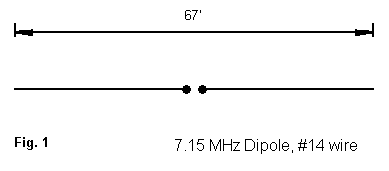
Placed high enough in the air, the 67' doublet performs very well. Its bi-directional pattern on 40 has good side QRM rejection, and with enough altitude, the elevation angle makes DX a real potential with every band opening. Let's place the antenna at a height of 66' (about 20 m) up and see what the models tell us that we can expect by way of performance.
Freq. Max. Gain TO VBW HBW Feedpoint Z MHz dBi Deg Deg Deg R +/- jX Ohms 7.15 7.3 28 35 86 70 - j 10 10.1 8.1 20 23 70 275 + j 800 14.15 9.0 15 16 51 4670 - j 345 18.1 10.5 11 12 33 175 - j 860 21.2 8.4 10 10 33 100 - j 115 24.95 9.3 8 9 33 375 + j 730 28.5 9.5 7 8 28 3265 + j 375
The TO angle is the elevation angle of maximum radiation. I have also provided information on the vertical and horizontal beamwidths (measured to the -3 dB points from the maximum strength bearing). We often neglect this information, but the data tell us some important facts. The vertical beam width is a rough measure of the range of elevation angles that we can count on for good communications. The horizontal beamwidth tells us how broad or narrow our signal is and hence how careful we must be in aiming the antenna--either when we build it or when we rotate it. (One of the amusing facets of reading lots of e-mail is discovering how many beam users demand 1-degree aiming accuracy when their beamwidths are well over 50 degrees.)
The 67' doublet shows the anticipated lowering of the TO angle as we increase frequency. As we increase the frequency, the antenna is increasing in electrical height, that is, its height as a fraction of a wavelength. So we expect the beam angle to be lower on the upper bands. The beam widths--both vertical and horizontal--narrow with rising frequency. Still, the vertical beamwidth is wide enough on all bands to catch the main stream of long-range skip. And the horizontal beamwidth is sufficiently broad to make aiming non-critical (but not unimportant).
The range of impedances at the antenna suggests that with a parallel transmission line and an ATU, we should be able to effect a match on all bands. 20 and 10 meters might present slight problems, but changing the line length will likely solve them by presenting the ATU with impedance values it can handle.
However, the gain column presents us with a small problem. The maximum gain of the 67' doublet occurs on 17-meters, takes a large dip above that band, and then slowly rises once more. For a simple wire, the actual gain numbers are not the problem. The question we want to ask is this: why does the dip occur?
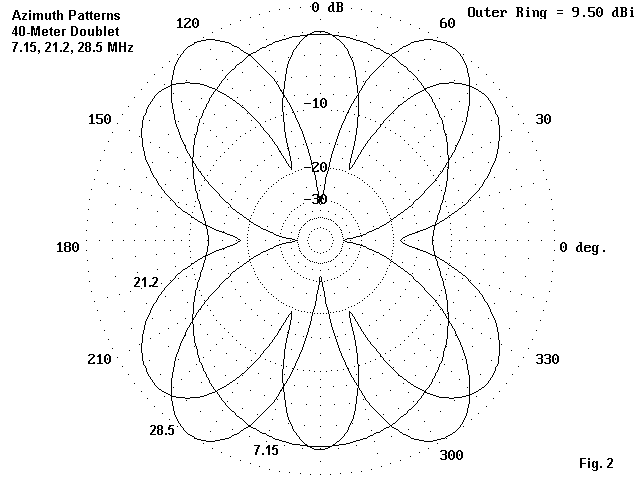
Fig. 2 can help us figure out what has occurred. The azimuth patterns overlaid on the plot are for 40, 15, and 10 meters. The 40-meter pattern is the typical oval. As we increase frequency, the oval grows narrower (decreasing horizontal beamwidth) while the gain increases--up to 17 meters. On this band, the 67' doublet is about 1.25 wl long: an extended double Zepp (EDZ). We expect about 3 dB gain over a dipole from an EDZ, and if we compare the 40-meter and 17-meter gain figures, we can see that we get it.
Above 17 meters, the antenna is longer than 1.25 wl. At 15 meters, the antenna is about 1.5 wl long. The main lobe is no longer broadside to the antenna, but, as shown in Fig. 2, it is broken into 6 distinct lobes. The lobes broadside to the wire are no longer the strongest. As we move into the 10-meter region, where the antenna is 2 wl long, we have a pattern composed of 4 lobes at roughly 40-degree angles to the wire.
For those unfamiliar with pattern development as an antenna becomes multiple wavelengths long, the following rules of thumb apply. For an antenna that is N wavelengths long, where N is an integer (like, 1, 2, 3), the number of lobes is twice the value of N. So a 2 wl antenna has 4 lobes, and a 1 wl antenna has only 2. For antenna lengths that are N.5 (like 1.5, 2.5, etc.), the number of lobes will be the sum of the number of lobes we get at N and at N+1. At 15 meters, where the antenna is 1.5 wl long, 1 wl gives us 2 lobes and 2 wl gives us 4 lobes, for a total of 6. The higher number at N.5 wl values arises because the new lobes are growing and the old ones shrinking--and they are nearly equal strength at the N.5 wl points.
The 44' Wire Solution
The problem with wire lengths over 1.25 wl is that we are no longer sure that we have a good signal broadside to our antenna. Suppose I put up a wire in Tennessee, running it NW to SE. That makes it broadside to Europe in one direction and to VK/ZL-land in the other. Not a bad set up. However, the main lobes for frequencies from 21 MHz up are no longer going where I want them to go. (Where they go may result in interesting contacts, but we set up our problem at the beginning so that it includes the need to keep our signals where we want them.)
There is a simple solution to this problem, but it may not be the one some folks would expect. Conventional wisdom tells us always to make antennas bigger and longer. However, the solution to our problem is to make our doublet shorter. Let's try a doublet that is 44' long, as in Fig. 3. Again, #14 or #12 AWG copper wire will do just fine for the antenna.
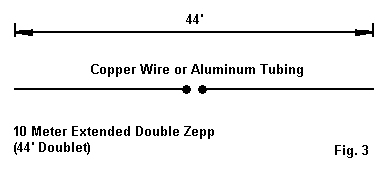
The first question we may now ask is whether we lose anything with the shorter wire. Let's find part of the answer in another table, modeled with the copper wire (#14 AWG) antenna 66' above average ground.
Freq. Max. Gain TO VBW HBW Feedpoint Z MHz dBi Deg Deg Deg R +/- jX Ohms 7.15 7.0 29 35 94 25 - j 580 10.1 7.6 20 23 83 55 - j 100 14.15 7.7 15 16 72 195 + j 485 18.1 8.6 12 12 60 920 + j1565 21.2 9.0 10 10 51 4160 + j 155 24.95 10.4 8 9 40 520 - j1545 28.5 10.4 7 8 31 140 - j 650
The gain figures begin about a quarter dB below the figures for the 67' doublet on 40 meters and climb steadily. The elevation angles of maximum radiation and the vertical beamwidths are virtually identical to those for the longer doublet. The shorter antenna provides a broader horizontal beamwidth on every band, which makes aiming less critical. The pattern of impedances offered at the feedpoint differs in detail from that of the longer doublet, but the values are manageable.
To see one of the major advantages of our short doublet, we should look at Fig. 4.
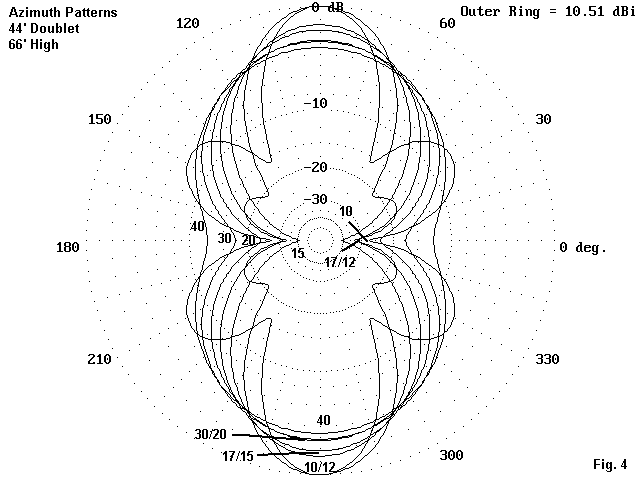
The composite azimuth patterns for the doublet on all of the bands for which it is intended have their major lobes exactly broadside to the wire. The 44' length was no accident. On 10 meters, this length is about 1.25 wl long, the standard EDZ length. The 10-meter pattern shows the anticipated strong main lobes plus the emerging "ears," secondary lobes that will become the major lobes at higher frequencies. On 15 meters, the antenna is about 1 wl long, and on 30 meters it is just under the right length for a half wl dipole (which is indicated by the low resistive impedance and the capacitive reactance for 10.1 MHz). On 40 meters, the antenna is between 1/3 and 3/8 wl long, about the minimum length we should use. Anything shorter would show very low resistance values and very high reactance values--a difficult situation for any ATU to handle.
If I wanted to aim at both Europe and at Australia and New Zealand on all bands from 40 through 10 meters, then the 44' doublet is the superior antenna to the longer 67' doublet. Of course, larger (102' or 135') all-band doublets break into fragmented lobe patterns at lower frequencies than the 40-meter dipole with which we started. So, if we make aiming one of the criteria for our antenna, the 44' doublet may be the way to go.
Two side notes. First, if we want to cover the bands only up through 20 meters, but want to include 80 and 75 meters within the frequencies for which we are well-aimed, then an 88' doublet would meet our needs. Of course, there is nothing magic in the precise length numbers chosen, since a length change of a foot or two will change almost nothing in terms of performance. The bands with the highest reactances at the feedpoint might show the greatest change in value as we alter the antenna length, but the feedpoint values on the other bands would hardly change enough for an ATU to notice.
Second, height is a major consideration with this sort of antenna. Perhaps 66' is not feasible for everyone. However, every foot of (safe) height that you can add to the antenna, the better it will work. This principle goes back to the days of George Grammer of ARRL, who preferred to add height rather than elements to his antennas. The idea is no less true today, although there are some limits. Once we get above 1 wl, there may be some holes in our DX elevation-angle coverage at certain antenna heights. However, in Grammer's day, only on 10 meters and VHF did most hams think about heights above 1 wl or so.
The Aluminum Alternative
There is no good reason why a single element antenna must be constructed from thin wire--excepting cost and ease of construction. If there is only one support that is high enough, then we might well consider constructing an aluminum tubing version of the 44' doublet. Fig. 5 shows one of many possible schemes for constructing the element.
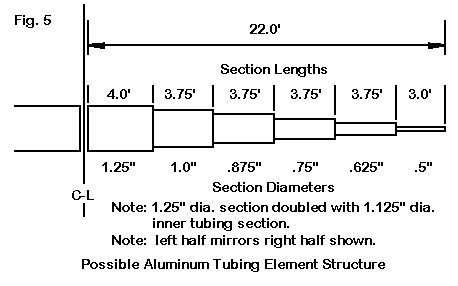
In tabular form, the element structure looks like the following partial antenna model description.
--------------- WIRES --------------- Wire Conn.--- End 1 (x,y,z : ft) Conn.--- End 2 (x,y,z : ft) Dia(in) Segs 1 -22.000, 0.000, 66.000 W2E1 -19.000, 0.000, 66.000 5.00E-01 3 2 W1E2 -19.000, 0.000, 66.000 W3E1 -15.250, 0.000, 66.000 6.25E-01 4 3 W2E2 -15.250, 0.000, 66.000 W4E1 -11.500, 0.000, 66.000 7.50E-01 4 4 W3E2 -11.500, 0.000, 66.000 W5E1 -7.750, 0.000, 66.000 8.75E-01 4 5 W4E2 -7.750, 0.000, 66.000 W6E1 -4.000, 0.000, 66.000 1.00E+00 4 6 W5E2 -4.000, 0.000, 66.000 W7E1 4.000, 0.000, 66.000 1.25E+00 9 7 W6E2 4.000, 0.000, 66.000 W8E1 7.750, 0.000, 66.000 1.00E+00 4 8 W7E2 7.750, 0.000, 66.000 W9E1 11.500, 0.000, 66.000 8.75E-01 4 9 W8E2 11.500, 0.000, 66.000 W10E1 15.250, 0.000, 66.000 7.50E-01 4 10 W9E2 15.250, 0.000, 66.000 W11E1 19.000, 0.000, 66.000 6.25E-01 4 11 W10E2 19.000, 0.000, 66.000 22.000, 0.000, 66.000 5.00E-01 3
The construction shown in the figure should be designated light to medium for the element length involved. It is based upon purchasing 8' lengths of aluminum and cutting them in half. Prices for 6061-T6 aluminum tubing from sources such as Texas Towers and others are quite reasonable. The tapering scheme allows for about 3" of tubing overlap at every junction. Any less overlap would jeopardize physical strength, while too much more overlap will unnecessarily increase the element weight. The double section of 1.25" and 1.125" diameter tubing at the center provides reinforcement for most mounting schemes.
Some builders prefer to alternate longer and shorter sections of tubing for greater overall strength. Whatever scheme one uses, analyzing it through a program such as YagiStress by Kurt Andress can go a long way toward ensuring a mechanically sound antenna. Nonetheless, the 44' doublet is only about 9' longer than most 20-meter Yagi reflectors and a good bit shorter than the elements used for 30-meter and 40-meter Yagis. Hence, the use of an aluminum tubing element is certainly feasible.
The use of aluminum tubing provides a small but determinate increase in electrical performance for the doublet. As we increase the diameter of an element, the RF resistance decreases considerably. Although copper wire is certainly efficient enough for most purposes, the tubing version of the antenna shows an increase in efficiency, despite the fact that the tubing version user aluminum, which has a higher resistivity than copper.
Frequency #14 Copper Wire Stepped-Dia. Aluminum MHz Efficiency (%) Efficiency (%) 7.15 96.98 99.70 28.50 98.35 99.77
Notice that the differential in efficiency grows less as the frequency increases, that is, as the wire diameter becomes a greater fraction of a wavelength. Nonetheless, the tubing version shows systematically higher gain values for each band than the wire version of the 44' doublet. Compare the following table with the copper wire table given earlier.
Freq. Max. Gain TO VBW HBW Feedpoint Z MHz dBi Deg Deg Deg R +/- jX Ohms 7.15 7.2 29 35 94 20 - j 410 10.1 7.7 20 23 83 50 - j 85 14.15 7.8 15 16 72 195 + j 295 18.1 8.7 12 12 60 1005 + j 845 21.2 9.1 10 10 51 1700 - j 705 24.95 10.5 8 9 40 285 - j 795 28.5 10.5 7 8 31 100 - j 375
The gain differences are certainly not large enough to make any kind of operational difference in using the 44' doublet. At most, they help us better understand some of the variables involved in antenna structures.
Notice also that the feedpoint impedance figures vary from the wire values more radically as the frequency increases--and also where the resistance or reactance values are high to begin with. The values shown--which will vary considerably as one changes the precise length of the finished antenna--are nonetheless quite manageable by most ATUs.
Supporting an aluminum doublet of the size we are suggesting is a considerable project. Fig. 6 shows the main aspects of the things we should consider.
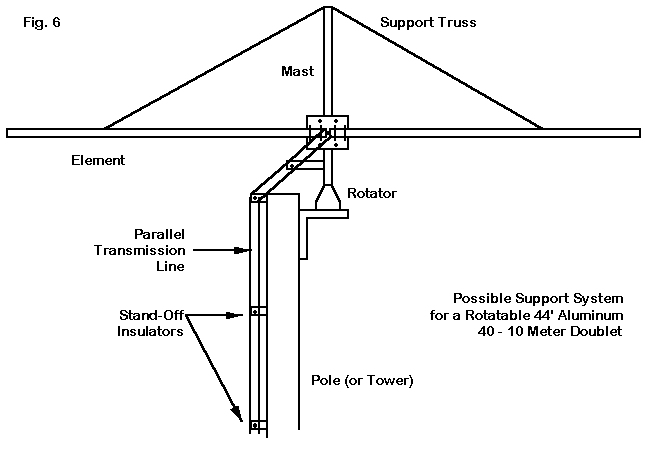
1. We shall need a support tower or pole as tall as we can safely make it. Although I know some inveterate climbers much older than I am who regularly scale high towers, my own experience tends to decrease my tower height by one section for every decade older I get. Safety comes first; antenna height second.
2. As I doodled the sketch in Fig. 6, I added a rotator for the fun of the prospect. We only need about 180-degrees rotation for this doublet, so a side mounting on an existing tower would likely be good enough.
3. For elements 40' and longer, consider adding a top-mounted truss to help support the element. A truss system will require a longer mast than trussless elements. The exact position on the element to place the ends of the truss depends a great deal on the precise element diameter schedule chosen. Use a weather and UV resistant material for the truss rope.
4. Since the antenna will use parallel transmission line, stand-off insulators will be necessary. If the antenna is to rotate, the position of the line from the feedpoint to the stationary supports on the pole will require considerable planning. The line should avoid close proximity to any metal in the mounting region.
5. The parallel transmission line is low loss inherently when the runs follow standard handbook recommendations. However, for lowest losses, consider true open-wire line rather than vinyl-coated lines. Even lines with "windowed" openings in the vinyl between the wires tend to show higher losses when wet than when dry.
Like all antennas, preventive maintenance at least once per year (every 6 months is better) will go a long way toward preventing unexpected catastrophic failures.
However, you decide to construct a single-element antenna, the 44' doublet has some interesting properties that provide advantages over other types of multi-band doublets. It is an antenna worth considering--if you can have only one wire.
Updated 03-01-2000. © L. B. Cebik, W4RNL. This item appeared in AntenneX, February, 2000. Data may be used for personal purposes, but may not be reproduced for publication in print or any other medium without permission of the author.